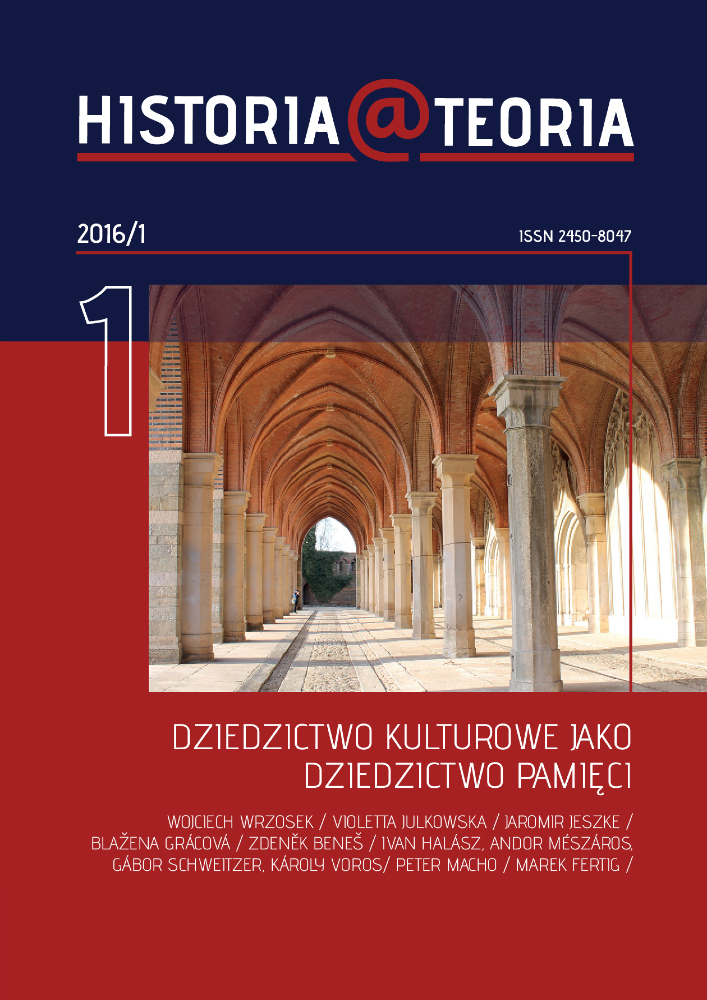Abstrakt
Th e local community of Bielawa and the areas in the region of the Owl Mountains is an interesting object for studies of sites of memory represented in local consciousness. Like most of similar communities on the so-called Recovered Territories, it started to form aft er 1945 on “raw roots” aft er the German inhabitants of the area were removed. Th ey were replaced with people moved from the former eastern provinces of the Second Republic, among others from Kołomyja, but also from regions of central Poland. Also Poles returning from Germany, France and Romania sett led there. Th e area taken over by new sett lers had not been a cultural desert. The remains of material culture, mainly German, and the traditions of weaving and textile industry, reaching back to the Middle Ages, formed a huge potential for creating a vision of local cultural heritage for the newly forming community. Th ey also brought, however, their own notions of cultural heritage to the new area and, in addition, became subject to political pressure of recognising its “Piast” character as the “Recovered Territories”. Th e present research is an att empt to fi nd out to what extent that potential was utilised by new sett lers, who were carriers of various regional (or even national) cultures, for their creation of visions of the future, as well as how the dynamics of those transformations evolved.Bibliografia
Bielawa, (online), dostęp: 10 marca 2015. [strona WWW] htt p://www.bielawa.net.pl.
Biblioteca Bielaviana, (online), dostęp: 10 grudnia 2014. [strona WWW] http://bibliothecabielaviana.com [strona WWW] http://mbp.bielawa.pl.
Brzeziński R., Życie w dawnej Bielawie, Ludzie, miejsca, wydarzenia, Wrocław 2008.
Dobrzaniecki H., Stacja Bielawa Zachodnia [West Bielawa Station], Nowa Ruda 2003.
Gimanzjum Publiczne w Głuszycy, (online), dostęp: 10 marca 2015. [strona WWW]:http://www.gimgluszyca.cba.pl/index.php?option=com_content&view=article&id=322:dziedzictwo-kulturowegor-sowich&catid=34:newsy.
Hotel Dębowy, (online), dostęp: 10 marca 2015. [strona WWW]: http://www.hoteldebowy.pl.
Krosno 1958, z. 14/15.
Mikos v. Rohrscheidt A., Raport: Analiza potencjału turystyczno-kulturowego powiatu dzierżoniowskiego (online) [Report: Analysis of the tourism and cultural potential of the Dzierżoniów County], dostęp: 05 maja 2015. [strona WWW]: Turystyka Kulturowa, 2013, 2, p. 69-85.
Łuczyński R.M., Tropami śląskiego dziedzictwa [Tracking the Silesian heritage], Wrocław 2000.
Pludro K., Kronika Bielawy. Część V. Lata 1945-1990 [Chronicle of Bielawa: Part V: 1945-1990],
Dzierżoniów 2002.
Pludro K., Kronika Bielawy. Od czasów najdawniejszych do 1945 r. [Chronicle of Bielawa: From the earliest times to 1945], Dzierżoniów 2007.
Pludro K., Kronika Bielawy. Lata 1990-2004 [Chronicle of Bielawa: 1990-2004], Dzierżoniów 2005. Stowarzyszenie Turystyczne Gór Sowich, (online), dostęp: 10 grudnia 2014. [strona WWW]: http://gorysowie.org.
Śnieżek T., Góry Sowie. Przewodnik, 2012.
Szynkiewicz A., Eulengebirgsbahn – czyli nierealne marzenie jakie zrealizowano, (online), dostęp: 25 marzec 2015. [strona WWW]: http://www.kolej.one.pl/~halski/linie/sowiogorska/eulen2.html.
W cieniu Wielkiej Sowy: Monografi a Gór Sowich, pod red. Przerwy T. i Śnieżka T., [red.] T. Przerwa & T. Śnieżek, Dzierżoniów 2006.
Licencja
Autorzy
Autorzy tekstów przyjętych do publikacji w czasopiśmie Historia@Teoria są zobowiązani do wypełnienia, podpisania i odesłania na adres redakcji umowy o udzielenie nieodpłatnej licencji do utworów, z zobowiązaniem do udzielania sublicencji CC.
Zgodnie z umową, autorzy tekstów opublikowanych w czasopiśmie Historia@Teoria udzielają Uniwersytetowi im. Adama Mickiewicza w Poznaniu niewyłącznej i nieodpłatnej licencji oraz zezwalą na użycie sublicencji Creative Commons Attribution-NoDerivatives 4.0 International (CC BY-ND 4.0).
Autorzy zachowują prawa do dalszego, swobodnego rozporządzania utworem.
Użytkownicy
Zainteresowani użytkownicy internetu uprawnieni są do korzystania z utworów opublikowanych od 2015 roku w Historia@Teoria pod następującymi warunkami:
- uznanie autorstwa - obowiązek podania wraz z rozpowszechnionym utworem, informacji, o autorstwie, tytule, źródle (odnośniki do oryginalnego utworu, DOI) oraz samej licencji;
- bez tworzenia utworów zależnych - utwór musi być zachowany w oryginalnej postaci, nie można bez zgody twórcy rozpowszechniać np. tłumaczeń, opracowań.
Inne
Uniwersytet im. Adama Mickiewicza w Poznaniu zachowuje prawo do czasopisma jako całości (układ, forma graficzna, tytuł, projekt okładki, logo itp.).
